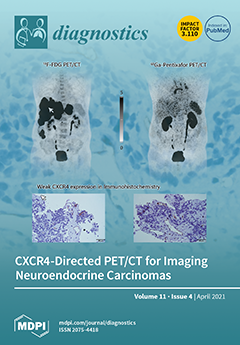According to European Society of Cardiology guidelines (ESC2015) for infective endocarditis (IE) management, modified Duke criteria (mDC) are implemented with a degree of clinical suspicion degree, leading to grades such as “possible” or “rejected” IE despite a persisting high level of clinical suspicion. Herein, we evaluate the
18F-FDG PET/CT diagnostic and therapeutic impact in IE suspicion, with emphasis on possible/rejected IE with a high clinical suspicion. Excluding cases of definite IE diagnosis, 53 patients who underwent
18F-FDG PET/CT for IE suspicion were selected and afterwards classified according to both mDC (possible IE/Duke 1, rejected IE/Duke 0) and clinical suspicion degree (high and low IE suspicion). The final status regarding IE diagnosis (gold standard) was based on the multidisciplinary decision of the Endocarditis Team, including the ‘imaging specialist’. PET/CT images of the cardiac area were qualitatively interpreted and the intensity of each focus of extra-physiologic
18F-FDG uptake was evaluated by a maximum standardized uptake value (SUVmax) measurement. Extra-cardiac
18F-FDG PET/CT pathological findings were considered to be a possible embolic event, a possible source of IE, or even a concomitant infection. Based on the Endocarditis Team consensus, final diagnosis of IE was retained in 19 (36%) patients and excluded in 34 (64%). With a sensitivity, specificity, positive predictive value (PPV), negative predictive value (NPV), and global accuracy of 79%, 100%, 100%, 89%, and 92%, respectively, PET/CT performed significantly better than mDC (
p = 0.003), clinical suspicion degree (
p = 0.001), and a combination of both (
p = 0.001) for IE diagnosis. In 41 patients with possible/rejected IE but high clinical suspicion, sensitivity, specificity, PPV, NPV, and global accuracies were 78%, 100%, 100%, 85%, and 90%, respectively. Moreover, PET/CT contributed to patient management in 24 out of 53 (45%) cases.
18F-FDG PET/CT represents a valuable diagnostic tool that could be proposed for challenging IE cases with significant differences between mDC and clinical suspicion degree.
18F-FDG PET/CT allows a binary diagnosis (definite or rejected IE) by removing uncertain diagnostic situations, thus improving patient therapeutic management.
Full article






